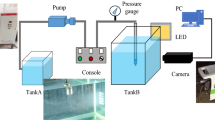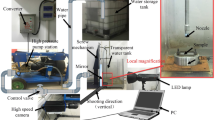Abstract
Experiments were conducted to investigate the cavitation behavior of Helmholtz self-sustained oscillation jets. In this paper, highspeed photographic technology was used to capture the flow details of cavitation with various nozzle structures and operating pressures from 1.0 MPa to 3.0 MPa. Furthermore, an in-house code based on a matrix approach that processes gray values with various statistical methods was used to quantitatively evaluate the cavitation jet of waters generated by Helmholtz nozzles. The mean values of the normalized gray levels of the images were used as a metric to measure the lengths of the cavitation clouds. When the original data were smoothed by a 15th lowess filter to exclude the noise of the images, the periods of cavitation cloud shedding were obtained accordingly, and the average period had a magnitude of 10-4. All of the smoothed results of the original data captured a two-peak shape that comprises a large peak and a mild hump. Image processing results showed that the Helmholtz nozzle produced greater cavitation intensity than a traditional conical nozzle. The shear-layer instability waves disappeared within 10d1 downstream from the injector exit. The cavitation clouds propagated a distance of approximately 1–10d1 at various pressure ratios, and the clouds were continuous within this distance. The geometry of the nozzle strongly affected the length and shedding period of the cavitation cloud. As described in the discussion section of this paper, when the cavity length was doubled, the length of the cavitation cloud decreased approximately 26.5 %; however, the period of the cavitation cloud shedding increased approximately 10 %. The longest cavitation cloud appeared when the ratio of the cavity diameter and the upper nozzle diameter was eight. Excessively small or large diameters were not conducive to the development of cavitation, whereas the effect of the pressure ratio on the cavitation cloud length was positive. When other conditions remained unchanged, the lump shedding period decreased as the pressure ratio was increased to 25. When the pressure ratio exceeded 25, the cavitation cloud shedding period remained constant.
Similar content being viewed by others
References
H. Soyama, Y. Yamauchi, Y. Adachi, K. Sato, T. Shindo and R. Oba, High–speed observations of the cavitation cloud around a high–speed submerged water jet, JSME International Journal Series B Fluids and Thermal Engineering, 38 (2) (1995) 245–251.
M. Hallberg and P. Strykowski, Open–loop control of fully nonlinear self–excited oscillations, Physics of Fluids, 20 (4) (2008) 041703.
M. Derks and A. Hirschberg, Self–sustained oscillation of the flow along Helmholtz resonators in a tandem configuration, 8th International Conference on Flow Induced Vibration, FIV (2004) 435–440.
W. Jungowski and G. Grabitz, Self–sustained oscillation of a jet impinging upon a Helmholtz resonator, Journal of Fluid Mechanics, 179 (1987) 77–103.
M. Yang, S. Xiao, C. Kang and Y. Wang, Effect of geometrical parameters on submerged cavitation jet discharged from profiled central–body nozzle, Chinese Journal of Mechanical Engineering, 26 (3) (2013) 476–482.
E. Rouly, A. Warkentin and R. Bauer, Design and testing of low–divergence elliptical–jet nozzles, Journal of Mechanical Science and Technology, 29 (5) (2015) 1993–2003.
T. Handa, A. Nakano, K. Tanigawa and J. Fujita, Supersonic mixing enhanced by cavity–induced three–dimensional oscillatory flow, Experiments in Fluids, 55 (4) (2014) 1711.
L. K. Forbes, R. A. Paul, M. J. Chen and D. E. Horsley, Kelvin–Helmholtz creeping flow at the interface between two viscous fluids, The ANZIAM Journal, 56 (4) (2015) 317–358.
H. G. Lee and J. Kim, Two–dimensional Kelvin–Helmholtz instabilities of multi–component fluids, European Journal of Mechanics–B/Fluids, 49 (2015) 77–88.
J. S. Na, E. K. Jin and J. S. Lee, Investigation of Kelvin–Helmholtz instability in the stable boundary layer using large eddy simulation, Journal of Geophysical Research: Atmospheres, 119 (13) (2014) 7876–7888.
T. Morel, Experimental study of a jet–driven Helmholtz oscillator, Journal of Fluids Engineering, 101 (3) (1979) 383–390.
R. Ma, P. E. Slaboch and S. C. Morris, Fluid mechanics of the flow–excited Helmholtz resonator, Journal of Fluid Mechanics, 623 (2009) 1–26.
D. Rockwell and E. Naudascher, Self–sustained oscillations of impinging free shear layers, Annual Review of Fluid Mechanics, 11 (1) (1979) 67–94.
J. Miles, Richardson’s criterion for the stability of stratified shear flow, The Physics of Fluids, 29 (10) (1986) 3470–3471.
S. Dequand, X. Luo, J. Willems and A. Hirschberg, Helmholtz–like resonator self–sustained oscillations, part 1: Acoustical measurements and analytical models, AIAA Journal, 41 (3) (2003) 408–415.
K. Sato, Y. Taguchi and S. Hayashi, High speed observation of periodic cavity behavior in a convergent–divergent nozzle for cavitating water jet, Journal of Flow Control, Measurement & Visualization, 1 (3) (2013) 102.
D. Li, X. Li, Y. Kang, X. Wang, X. Long and S. Wu, Experimental investigation on the influence of internal surface roughness of organ–pipe nozzle on the characteristics of high speed jet, Journal of Mechanical Engineering, 51 (17) (2015) 169–176.
C. K. Holland and R. E. Apfel, Thresholds for transient cavitation produced by pulsed ultrasound in a controlled nuclei environment, The Journal of the Acoustical Society of America, 88 (5) (1990) 2059–2069.
A. Y. Kravtsova, D. Markovich, K. Pervunin, M. Timoshevskiy and K. Hanjalić, High–speed visualization and PIV measurements of cavitating flows around a semicircular leading–edge flat plate and NACA0015 hydrofoil, International Journal of Multiphase Flow, 60 (2014) 119–134.
Y. Long, X. Long, B. Ji, W. Huai and Z. Qian, Verification and validation of URANS simulations of the turbulent cavitating flow around the hydrofoil, Journal of Hydrodynamics, Ser. B, 29 (4) (2017) 610–620.
X. Long, H. Cheng, B. Ji and R. E. Arndt, Numerical investigation of attached cavitation shedding dynamics around the Clark–Y hydrofoil with the FBDCM and an integral method, Ocean Engineering, 137 (2017) 247–261.
X. Peng, B. Ji, Y. Cao, L. Xu, G. Zhang, X. Luo and X. Long, Combined experimental observation and numerical simulation of the cloud cavitation with U–type flow structures on hydrofoils, International Journal of Multiphase Flow, 79 (2016) 10–22.
H. Tani, S. Teramoto and K. Okamoto, High–speed observations of cryogenic single and coaxial jets under subcritical and transcritical conditions, Experiments in Fluids, 56 (4) (2015) 85.
L. Jiang and A. K. Agrawal, Spray features in the near field of a flow–blurring injector investigated by high–speed visualization and time–resolved PIV, Experiments in Fluids, 56 (5) (2015) 103.
X. Long, J. Zhang, J. Wang, M. Xu, Q. Lyu and B. Ji, Experimental investigation of the global cavitation dynamic behavior in a venturi tube with special emphasis on the cavity length variation, International Journal of Multiphase Flow, 89 (2017) 290–298.
E. Brujan, T. Ikeda, K. Yoshinaka and Y. Matsumoto, The final stage of the collapse of a cloud of bubbles close to a rigid boundary, Ultrasonics Sonochemistry, 18 (1) (2011) 59–64.
X. Long, Q. Liu, B. Ji and Y. Lu, Numerical investigation of two typical cavitation shedding dynamics flow in liquid hydrogen with thermodynamic effects, International Journal of Heat and Mass Transfer, 109 (2017) 879–893.
K. Peng, S. Tian, G. Li, Z. Huang and Z. Zhang, Cavitation in water jet under high ambient pressure conditions, Experimental Thermal and Fluid Science, 89 (2017) 9–18.
R. Watanabe, T. Kikuchi, T. Yamagata and N. Fujisawa, Shadowgraph imaging of cavitating jet, Journal of Flow Control, Measurement & Visualization, 3 (3) (2015) 106.
B. Ji, J. Wang, X. Luo, K. Miyagawa, L. Z. Xiao, X. Long and Y. Tsujimoto, Numerical simulation of cavitation surge and vortical flows in a diffuser with swirling flow, Journal of Mechanical Science and Technology, 30 (6) (2016) 2507–2514.
S. Li, Y. Li and A. Zhang, Numerical analysis of the bubble jet impact on a rigid wall, Applied Ocean Research, 50 (2015) 227–236.
N. Jeffers, J. Stafford, C. Conway, J. Punch and E. Walsh, The influence of the stagnation zone on the fluid dynamics at the nozzle exit of a confined and submerged impinging jet, Experiments in Fluids, 57 (2) (2016) 17.
E. Klaseboer, K. Hung, C. Wang, C. Wang, B. Khoo, P. Boyce, S. Debono and H. Charlier, Experimental and numerical investigation of the dynamics of an underwater explosion bubble near a resilient/rigid structure, Journal of Fluid Mechanics, 537 (2005) 387–413.
I. Z. Naqavi, P. G. Tucker and Y. Liu, Large–eddy simulation of the interaction of wall jets with external stream, International Journal of Heat and Fluid Flow, 50 (2014) 431–444.
A. Berchet, L. Thomas, P. Braud and L. David, Instantaneous volumic concentration and velocity measurements of a jet in crossflow for the evaluation of the entrainment, Experiments in Fluids, 54 (12) (2013) 1608.
G. H. Chen, G. Y. Wang, C. L. Hu, B. Huang and M. D. Zhang, Observations and measurements on unsteady cavitating flows using a simultaneous sampling approach, Experiments in Fluids, 56 (2) (2015) 32.
G. Cafiero, G. Ceglia, S. Discetti, A. Ianiro, T. Astarita and G. Cardone, On the three–dimensional precessing jet flow past a sudden expansion, Experiments in Fluids, 55 (2) (2014) 1677.
K. M. Kalumuck, G. L. Chahine and G. S. Frederck, The influence of ambient pressure and nozzle shape on submerged water jet velocity and spreading, 7th American Water Jet Conference, Washington, USA (1993) 262.
Author information
Authors and Affiliations
Corresponding author
Additional information
Recommended by Associate Editor Sangyoup Lee
Qiang Wu is a first-year master’s student who is majoring in the dynamics of jet flow engineering in the School of Energy and Power Engineering at Wuhan University of Technology. His areas of interest include multiphase flow and cavitation of jet flow.
Zhenlong Fang is a lecturer in the School of Energy and Power Engineering at Wuhan University of Technology. His major research orientations are flow mechanisms and cavitation characteristics of Helmholtz self-sustained oscillation jets.
Rights and permissions
About this article
Cite this article
Wu, Q., Wei, W., Deng, B. et al. Dynamic characteristics of the cavitation clouds of submerged Helmholtz self-sustained oscillation jets from high-speed photography. J Mech Sci Technol 33, 621–630 (2019). https://doi.org/10.1007/s12206-019-0117-4
Received:
Revised:
Accepted:
Published:
Issue Date:
DOI: https://doi.org/10.1007/s12206-019-0117-4




